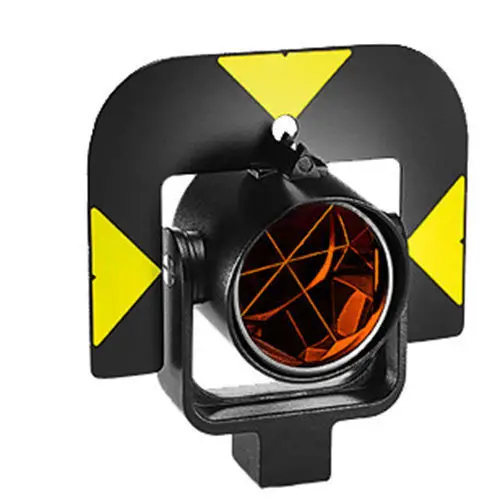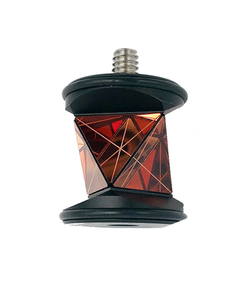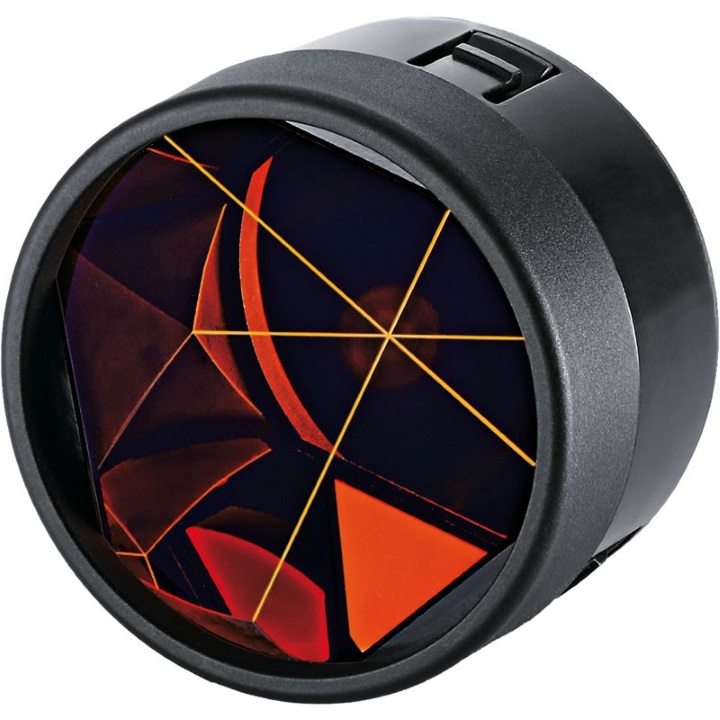Prism Model |
Leica Offset |
Actual Offset |
Diagram |
Alternative Model |
GPH1P |
0.0 |
-34.4 |
  |

GPH1P |
GPR121GPR111 |
0.00.0 |
-34.4-34.4 |

|

LSP-LT |
GMP101 |
+17.5 |
-16.9 |
  |

LT101 |
GMP111GMP111-0 |
+17.50.00 |
-16.9-34.4 |
|

LT111 |
Reflective Tape |
+34.4 |
0.0 |
  |

REFLECTIVE TAPE |
CPR105 |
+34.4 |
0.0 |
  |

LT105 |
GRZ4 |
+23.1 |
-11.3 |
  |

360P |
GRZ122 |
+23.1 |
-11.3 |
  |

GRZ122 |
GRZ101 |
+30.0 |
-4.4 |
  |

360MINI |
Absolute Offsets0.
Setting the correct prism constant is a simple operation but sometimes leads to some confusion and the cause of systematic errors in survey measurements. Common corner cube prisms used with electronic distance measuring (EDM) instruments have an offset due to the fact that the transmitted light beam from the EDM takes longer to enter and exit the prism. Common offsets are 0, -17.5 mm, -30 mm, -34 mm, and -40 mm. This longer time translates to a longer distance measured. This distance is corrected by using an “offset” and/or positioning the prism in relationship to the plumb line of the prism holder.
The distance that the user wants is the distance from the centre of the instrument (vertical axis) to the vertical axis (plumb line, Diagram A) of the prism holder. However, the path of the beam includes the distance the beam must travel through the prism (distance a+b+c, Diagram A) and must be corrected for this “extra” distance and the effect on the speed of light when the beam travels through the glass instead of air. We call this value (Kr) the absolute offset (also known as the manufacturers offset) and in most circumstances the absolute offset is what is quoted on the prism systems target or holder. The exception to the rule, however, are prism’s manufactured by Leica Geosystems.
The manufacturers Nikon, Pentax, Sokkia, Topcon, Trimble, Geodimeter, Wild Heerbrugg and Zeiss all define the prism constant as a correction, that is, as a correction of the measured distance based on the physical and design characteristics of the prism or reflector in the instrument. The magnitude of the prism constant is determined by the distance between the vertical axis of the prism holder and target point (Diagram A) and the theoretical turning point (So) of the measuring beam, which is behind the glass. If the vertical axis is situated right at point (So, Diagram A), then the Prism Constant equals 0. In other commercially available prisms the vertical axis is always in front of the point (So). The measured distance will then be too long and the corresponding correction (prism constant Kr, Diagram A) will be negative. If the vertical axis runs through the centre of the prism (commonly referred to as the nodal point), the prism has the best mounting from the point of view of error correction. In this case, inaccurate prism alignment in the total station will have a minimal effect on measurements of angles and distances. Prism sets that follow these design principles are know as nodal prism sets. They are popular amongst engineering surveyors due to there constant accuracy regardless of the prism angle in the holder.
For More info on our Prisms Click Here.
Leica’s Prism Offset System
Leica uses a different prism offset method than other manufacturers (and they are the only company to do so). The difference between a Leica prism quoted offset and all other prism offsets is the way the Kr value is handled. Leica’s prism constant system is defined with reference to its standard prism sets (the GPH1 + GPR1) which has a Kr value equal to -34.4 mm. This is the value that Leica used for many years and, being a nodal prism, it considered it to be the the optimal design to eliminate any deviations of the beam when the prism face is tilted or not perpendicular to the path of the EDM beam. Now that we understand that Leica Geosystem’s uses a prism constant of -34.4 mm for their optimal prism design we can begin to see where all the confusions is created. In Leica’s Total Stations this value is set to 0 mm (Kl). Leica builds from defining this as the base point of 0 mm. The offsets for their other prisms and retro reflectors are offsets from the base point as opposed to the actual Kr value. Knowing that Leica’s 0mm base point is actually -34.4 mm we are now able to perform a conversion and can calculate the absolute offset (Kr) if we know the Leica Offset or visa versa.
Thus if non-Leica prisms are to be used with Leica systems or if Leica prisms are to be used with non-Leica systems, the below conversion methods must be applied. If a non-Leica prism with a given prism constant (Kr) is to be used with a Leica total station, 34.4 mm must be added to the value. This is the adjustment that must be made on the Leica total station. If, on the other hand, a Leica prism with a Leica system constant is to be used with a non-Leica total station, 34.4 mm must be subtracted. Example for the Leica 360° prism GRZ121 with a Leica constant of +23.1 mm: +23.1 mm -34.4 mm = -11.3 mm. This is the adjustment (rounded off, if necessary) that must be made on the non-Leica total station. The following table takes these considerations into account, showing the constants of the most common commercially available prisms and reflectors for non-Leica systems and for the Leica system. In modern total stations, these constants can be entered directly and called up via hotkeys. Measured distances are thus corrected automatically.
Using Non-Leica prisms with a Leica system:
Leica Offset (Kl) = Absolute Offset (Kr) + 34.4 mm
Example 1. A Sokkia 62mm prism has a quoted offset (Kr) of -30. Because the EDM software in a Leica total station is programmed with a +34.4mm we have to subtract 34.4 from the Kr value to come up with the Leica Offset (Kl). ie -30 + 34.4 = 4.4mm
Using a Leica prism with a non-Leica system:
Absolute Offset (Kr) = Leica Offset (Kl) – 34.4 mm
Example 2. The Leica GPH1 (Leica’s optimal prism design) has a quoted Leica offset of zero. Because the EDM software in a Leica total station is programmed with a +34.4mm (for the optimal prism design) the prism offset that Leica quote on the prism is 0 mm. The absolute offset is actually -34.4 mm (0 – 34.4)
Example 3. The Leica mini stakeout prism (LT101) has a quoted prism offset of +17.5 mm (Kl). The absolute offset is actually +16.9 mm (17.5 – 34.4).
Common Leica Prism Absolute Constant values
The following table takes these considerations into account, showing the constants of the most common Leica prisms and reflectors for non-Leica systems and for the Leica system. In modern total stations, these constants can be entered directly and called up via hotkeys. Measured distances are thus corrected automatically. To avoid having to change the settings for constants in the total station when a prism is changed, one should use standard prisms or prisms of other manufacturers with identical constants. This can be difficult however when moving from larger to smaller prisms so in reality two offsets is more reasonably attainable.
For some additional information have a read of this article further detailing the Leica Prism Constants.





